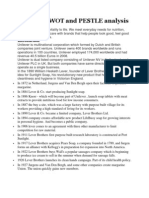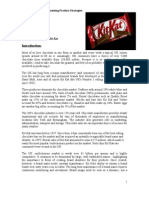BA Essay
BA Essay
Uploaded by
Ruta GupteCopyright:
Available Formats
BA Essay
BA Essay
Uploaded by
Ruta GupteOriginal Title
Copyright
Available Formats
Share this document
Did you find this document useful?
Is this content inappropriate?
Copyright:
Available Formats
BA Essay
BA Essay
Uploaded by
Ruta GupteCopyright:
Available Formats
1 Student Number 19007808
ECM- 19 Business Analysis
Essay 1: Describing market structure and effect of market structure on market outcomes of an industry (Oligopoly market structure).
University of Reading
School of Economics Msc International Business and Finance December 2010
Table of Contents 1. INTRODUCTION
2. OLIGOPOLY MARKET STRUCTURE
3. CHOCOLATE CONFECTIONARY INDUSTRY: NESTLE
4. CHOCOLATE CONFECTIONARY INDUSTRY: CADBURY
5. ANALYSIS OF NESTLE AND CADBURY COMPANIES
6. CONCLUSION
7. REFERENCES
Introduction This essay will describe the market structure of firms in an oligopolistic industry. It will also cover the effect of market structures on market
3 structures like, output, price and profits and the strategic interaction between the firms with reference to the real world evidence. Let us first understand what business analysis means since the essay requires us to analyze industrial market structures of different firms. Business analysis involves analyzing the strategic decision making of a business or firm in a particular market structure. The industry structure is divided into different type of market structures and each structure has unique nature. It is an analytical tool, which involves a set of tasks, knowledge, techniques and methods required to determine the needs of a business organization and to find optimal solutions to the business problems. It is distinct from financial analysis, which takes into account only the financial, and money aspect of a business organization. Usually a specialist is appointed to take analyze the requirements of the organization and problems in the business. Those performing these specialist functions are called Business analysts. A business analyst has the expertise to analyze business problems, changes in the market situations or any turmoil in business. He then makes suggestions or gives solutions to enable the organization to achieve its goals.
Oligopoly market structure Let us first understand what market structure means. (Waldman and Jensen, 2001) A market structure is a setting or an environment in which different type of buyers and sellers exist. The behavior of a certain firm is influenced by the type of market structure it which it
4 exist. The industry can be divided into 3 main market structures, viz Monopoly, Perfect Competition and Oligopoly. Monopoly is the market structure where there is only one seller and many buyers. Examples of Monopolistically competitive markets are, Furniture, Costume jewelry, textiles and Restaurants. In perfect competition, there are many buyers and sellers and they are insignificant enough to affect the market. In this essay, we are going to discuss the Oligopoly market structure. Augustin Cournot and Joseph Bertrand made the first advances in the area of oligopoly theory in the 19th century. In oligopoly market structure there is competition among 2 or more firms. Therefore, there is scope for strategic interdependence between firms. Every oligopolistic firm is large enough to influence the market conditions; therefore it has market power, which affects the market conditions faced by all the rival firms. Duopoly competition is considered to be a type of Oligopoly, in which there are only 2 sellers or firms. In Duopoly, the firms are either output- oriented or price oriented. The firms choice of output level or price level is determined by the choices made by its rival companies. Deciding what output level or price level a firm should choose depends on the level its rival chooses. This problem can be solved using Game Theory. This game theory involves different models of oligopoly, viz Cournot duopoly, Stackelberg duopoly, Bertrand duopoly, simultaneous and sequential games. Examples of some oligopolistic industries are manufacturing industries like automobiles, steel, pharmaceuticals, cereals, soft drinks, beer, etc. (Waldman and Jensen, 2001).1 In this essay we are going to
5 observe the nature of firms in an oligopolistic industry and analyze its strategic interdependence on it rival firms. We will take into consideration analysis of Chocolate Confectionary Industry. A food product, which has high level of sugar content in it, is called a Confectionary. It is basically a low nutrition food item, which is rich in calories. Chocolate Confectionary Industry The main manufacturers in the Chocolate Confectionary industry all around the globe are Cadbury, Nestle, Lindt, Hersheys etc. Chocolate industry is well recognized by its brand names. Let us explain brief history, market structures, success stories and make comparison between the two most popular chocolate confectionaries in the world viz, Nestle and Cadbury. The later part of the essay will be covered by analysis of both firms with respect to various aspects in the market structure.
Nestl Henri Nestle started the Nestle Company around 1866 in Switzerland. The key factor behind starting this company was to search for hale and hearty, wholesome and inexpensive replacement for breastfeeding for mother who could not feed their infants. His main aim was to get to the bottom of the problem of infant mortality caused by malnutrition. He begun experimenting and named the new product Farine Lactee Henri
6 Nestle. People realized the worth of this new product when it saved an infants life. Within few years time, Farine Lactee Henri Nestle was being sold in the markets in Europe. (Nestle Website)2 By adopting his own coat of arms (Nestle mean little nest) as trademark in Swiss German, he demonstrated early signs of branding. The Anglo- Swiss Condensed Milk Company was an American competitor of Nestle. It was founded in 1866. It also extended its product in cheese and infant formulas. It was observed that many important events like mergers took place in those early years. By the end of the century, Henri Nestls company had merged with different companies and entered the market of different product line like soups, chocolate milk, chocolate bars etc. around the 1900s, Nestle expanded its production to major trading countries; America, Britain, Germany and Spain. After entering into an agreement with Swiss General
Company in 1904, Nestle started producing chocolates along with its other food products. By 1907, the company began full-fledged manufacturing in Australia, which is the second largest in its export. It soon entered the Asian markets. Separate warehouses were built in Singapore, Hong Kong, and Bombay to supply to the growing demand of its products in the Asian markets. The beginning of world war affected the company immensely. But it was able to generate new demand for its dairy products in the form of government contracts. In order to match up to its competitors Nestle bought several factories in America. By the end of the war period, Nestle had expanded its production worldwide and installed 40 more factories. In 1921, Nestle
7 Company faced its first loss. The main reasons for it were increase in the price of the raw materials, post war economic crisis and falling exchange rates. In the year 1930, the company entered the product line of coffee making and named it Nescafe, which was followed by Nestea in 1940, after its instantaneous success. The effects of World War II were felt deeply by Nestle. There were huge losses during period 1938-1939. There after, Nestle recovered and made more expansions. Today Nestle is an acknowledged leader in the world in the food and beverage industry. It has around 470 factories across the globe and sales of more than 81 billion.
Cadbury John Cadbury founded the Cadbury Company around 200 years ago in 1820. He started with a small grocery shop in Birmingham, UK and went on to become successful manufacturer of cocoa and drinking chocolate. In the year 1905, Cadbury launched the globe renowned Dairy Milk bar and Bourneville Chocolate. The period between 19011940 saw some great success. It was successful in opening several factories abroad. Also it became one of the UKs biggest brands during this time period. The mid 20th century experienced growth and success. Post war it had to undergo organizational changes. During the period 1941-1980, Cadbury merged with a drinks company called Schweppes in 1969. The main aim of Cadbury was to get hold of resources in international markets. Since the last thirty years Cadbury Company has seen growth and international accomplishment. It has
8 become worlds number 1 company in confectionary industry. In the year 2008, Cadbury and Schweppes, demerged. It resulted in separation in its businesses, products relating to drinks and
confectionary. The decision of demerging was made so that both of the companies could enjoy its profits in its area of expertise. By 2009, the Cadbury Company is flourishing. It has been successful in
implementing factories overseas including Africa, Australia, Japan and India. (Cadbury website)3
Analysis of Nestle and Cadbury Companies We can analyze the market structure of both the Chocolate
Confectionaries with respect to branding strategies, pricing strategies, advertising strategies etc. We see that, the Cadbury Company was founded in the year 1820 whereas Nestle was started in the year 1866. Here we can analyze that since Cadbury came into the market 46 years before, it has a greater market due to the first mover advantage like in the case of Stackelberg competition. We can say that Cadbury is the stackelberg leader in this situation. Nestle has undergone a number of successful mergers and received government support during the post war period. It was successful in grabbing the market
9 opportunities. Cadbury merged with Schweppes to get hold of international resources but then later on it decided to demerge. Both the companies expanded their business overseas to tap international profit and resources. This situation can be interpreted as being a situation of prisoners dilemma game theory. Wherein, one player follows the lead of the other. Henri Nestle adopted a trademark of his own coat of arms (Nest) in Swiss German. He presented a trademark, which was a sign of branding the products of Nestle Company. Cadburys has an exclusive branding strategy. It tries to concentrate on consumers emotional side. Since it has been in the market for around 200 years it has been successful in securing consumer loyalty by branding its products. The trademark of Cadbury is a purple color wrapper. Figure: 1
10
If we observe the above figure, we can see that in 2009, Cadbury has the highest share in the global confectionary market, i.e. 14.8% while Nestle has the third largest share, i.e. 7.8%. But depending on the region or country the market share of Brands keep on changing. Cadbury has maintained its undoubted leadership in the chocolate confectionary industry worldwide. This makes him the stackelberg
leader in this situation. There exist heavy competition among both the brand. Both the firms compete with the advertising strategies. The strategies adopted by Cadbury attract the consumers by adopting various innovative and new means of advertising. But a big company like Cadbury after surviving in the market for so many years becomes a big brand name itself. Then all the other brands compete with it for
11 gaining customers attention. Pricing strategies are usually determined by the market share of the firm and demand for the product of the firm. Nestle adopts integrated pricing strategy, leadership and deals in broad range of products. It charges low prices in order to attract the local as well as customers who prefer imported brands. Cadbury brand is highly quality indulgent, there for customers who are loyal to the brand always buy it irrespective of the price. The price of the product is dependent or other external factors too. For example, same products might differ in price in different locations. Furthermore, the success for a brand also depends upon the type of customer at which is targeted. For example, nestle is preferred by the young and urban people whereas Cadbury is preferred by both kids and adults. The market of a company is at some level can be interpreted by the products manufactured by the company. Nestle deals with milk products & Nutritional foodstuffs, Beverages, Chocolates and Coffee, whereas, Cadburys product line includes Chocolates, Snacks, Beverages and Candy.
Figure: 2
12
In the above figure in 2009, the top players in the confectionary market are shown. We can see that Cadbury has a market share of 10.3% (before Kraft offered it a bid of 16 billion) and Nestle of 7.6%. Figure: 3
In the given figure, we can see the difference in the prices of the Nestle and Cadbury.
Conclusion
13 Thus we can observe that the above essay gives a detailed explanation of the various market strategies adopted by firms in a confectionary industry. The market structure of chocolate
confectionary industry is similar to that of an oligopolistic market structure. There are only few top players in this industry who have maintained its position in the market for many years. In this essay we compared the various market aspects of the Cadbury Company and Nestle and analyzed them with theories of oligopoly market structure. We observed that clearly Cadbury Company is the top player in the industry, since it has the first mover advantage. Being a Stackelberg leader Cadbury Company has been successful in creating a brand name for itself in the market. But Nestle Company had foresighted profit opportunities by merging with companies dealing with products other than chocolates. It expanded its horizon in different fields of products. Nestle and Cadbury have been competing with each other to secure consumer loyalty. If we compare the real life evidence to the theories in the oligopoly market structure, we can observe that some of the theories are not applicable in the real world. For example, in a Cournot duopoly, the price level of the firms is same and the firm competes with respect output. In case of Bertrand Competitions, the firms compete only on price levels of firms, but in reality there are many more elements involved in addition to price level. Appendix
1. Figure 1: Credit Suisse equity research,
14 http://www.leafandbean.org/wordpress/2010/01/19/cadburysbought-out-by-kraft/ 2. Figure 2: Euromonitor; The wall street journal http://www.topstockanalysts.com/cmnts/2009/09-11-09-kraft.asp 3. Figure 3: The daily mail (online) http://www.dailymail.co.uk/news/article-541011/How-Eastertreats-come-8-000-TONS-waste-packaging.html
References Book Resources: Waldman and Jensen, 2001 Industrial Organization: Theory and practice, Addison-Wesley.
1
15 Church and Ware (1999) Industrial Organization: A Strategic Approach, McGraw-Hill
Online Resources: Cadbury3 http://www.cadbury.co.uk/cadburyandchocolate/ourstory/Pages/o urstoryFlash.aspx Nestle
2
http://www.nestle.com/AllAbout/History/HistoryList.htm Euromonitor http://www.euromonitor.com/&DCMP=AFC-MRW Management Paradise http://www.managementparadise.com/forums/publish-uploadproject-download-reference-project/153917-cadbury-v-snestle.html
Journal Articles (online) Endogenous Quality Choice: Price vs. Quantity CompetitionAuthor(s): Massimo MottaSource: The Journal of Industrial Economics, Vol. 41, No. 2 (Jun., 1993), pp. 113131Published by: Blackwell PublishingStable URL: http://www.jstor.org/stable/2950431Accessed: 13/12/2010 08:09
16 Market Structure and Productivity: A Concrete ExampleAuthor(s): Chad SyversonSource: The Journal of Political Economy, Vol. 112, No. 6 (Dec., 2004), pp. 1181-1222Published by: The University of Chicago PressStable URL: http://www.jstor.org/stable/3555278Accessed: 12/12/2010 22:21
Other sources: Dr. Lynda Porter, Business Analysis Lecture Handout, 2010, University of Reading.
You might also like
- English HKSI LE Paper 1 Pass Paper Question Bank (QB)Document10 pagesEnglish HKSI LE Paper 1 Pass Paper Question Bank (QB)Tsz Ngong Ko0% (2)
- Sunzi Complete AssignmentDocument11 pagesSunzi Complete AssignmentCalonneFrNo ratings yet
- Unilever SWOT and PESTLE AnalysisDocument9 pagesUnilever SWOT and PESTLE AnalysisMahbub Alam100% (3)
- Parts List As Per Electric Service TruckDocument3 pagesParts List As Per Electric Service TruckJean Jacques ouandaNo ratings yet
- Case Study On UnileverDocument4 pagesCase Study On UnilevermonikaNo ratings yet
- Tootsie Roll-Final PaperDocument19 pagesTootsie Roll-Final Paperapi-240320161No ratings yet
- Nestle Brand Management Case StudyDocument4 pagesNestle Brand Management Case StudySurajit Sarbabidya0% (1)
- TOWS AnalysisDocument9 pagesTOWS AnalysisBinda Kular100% (1)
- Global Brand Power: Leveraging Branding for Long-Term GrowthFrom EverandGlobal Brand Power: Leveraging Branding for Long-Term GrowthRating: 5 out of 5 stars5/5 (1)
- FMCG Industry: DefinitionDocument14 pagesFMCG Industry: Definitionsamujjwal88No ratings yet
- Nestle ProjectDocument26 pagesNestle Projectharisnraja0% (1)
- Chapter 1Document25 pagesChapter 1Jezza Mae Gomba RegidorNo ratings yet
- Maggi ReportDocument46 pagesMaggi ReportLucky AgrawalNo ratings yet
- Nestle Company MKNG ProjectDocument35 pagesNestle Company MKNG ProjectHumayun100% (33)
- Chocoday 1Document26 pagesChocoday 1Aditya ChauhanNo ratings yet
- P N G....Document28 pagesP N G....Karishma LodhaNo ratings yet
- Chapter 1Document25 pagesChapter 1JeAnne100% (5)
- Choco DayDocument26 pagesChoco DayAditya ChauhanNo ratings yet
- Nestle Juices Project FinalDocument53 pagesNestle Juices Project Finaltalha riaz87% (30)
- Cadbury Marketing PlanDocument27 pagesCadbury Marketing PlanAjaz AhmedNo ratings yet
- Coca Cola Research PaperDocument14 pagesCoca Cola Research PaperOussama MimoNo ratings yet
- Coca Cola Pepsi ColaDocument18 pagesCoca Cola Pepsi Colamuhendis57No ratings yet
- Synopsis: A Comparative Analysis of Unilever, Procter & Gamble and Nestle (6 Trimester)Document4 pagesSynopsis: A Comparative Analysis of Unilever, Procter & Gamble and Nestle (6 Trimester)Manisha TripathyNo ratings yet
- Case Study-Cereal PartnersDocument5 pagesCase Study-Cereal PartnersTariq MehmoodNo ratings yet
- Bristol Institute of Business Management: UMKDFG-15-M Customer and International Market Analysis Feasiblity ReportDocument14 pagesBristol Institute of Business Management: UMKDFG-15-M Customer and International Market Analysis Feasiblity Reportbashini chathurikaNo ratings yet
- Nestle Vs CadburyDocument45 pagesNestle Vs CadburyPavit Kohli44% (9)
- Fall 2021 INB 372 (International Business) Student Learning Assessment (SLA) CaseDocument10 pagesFall 2021 INB 372 (International Business) Student Learning Assessment (SLA) CaseAmmer Yaser MehetanNo ratings yet
- Marketing Plan CadburyDocument15 pagesMarketing Plan CadburyMaxim CuRsunji100% (2)
- Unit 5: Note/Summary Completion Practice 1Document4 pagesUnit 5: Note/Summary Completion Practice 1Đặng Thị Ngọc YênNo ratings yet
- Unit 5: Note/Summary Completion Practice 1Document4 pagesUnit 5: Note/Summary Completion Practice 1Nhan NguyenNo ratings yet
- Chapter 12Document14 pagesChapter 12mohamed elnagdyNo ratings yet
- Nestlé 1st Home AssignmentDocument9 pagesNestlé 1st Home AssignmentLilla OroviczNo ratings yet
- Assignment 2Document26 pagesAssignment 2nikhilNo ratings yet
- Marketing Analysis: ColgateDocument30 pagesMarketing Analysis: ColgateSiddhardha Karanam78% (9)
- Multinational Corporation (Or Transnational Corporation)Document19 pagesMultinational Corporation (Or Transnational Corporation)pramrutaNo ratings yet
- 1Document21 pages1faisal2alamNo ratings yet
- An Overview of NestleDocument24 pagesAn Overview of NestleFatheha JuieNo ratings yet
- Financial Plan For MyMuesli (Only Market Research)Document14 pagesFinancial Plan For MyMuesli (Only Market Research)mevasaNo ratings yet
- Case Analysis of P&GDocument16 pagesCase Analysis of P>ewelde Mezgobo83% (12)
- Comparative Analysis of The Marketing Communications Mix For Three Companies in The Cola Drinks Sector: Coca Cola, Pepsi Cola and Sainsbury Own BrandDocument26 pagesComparative Analysis of The Marketing Communications Mix For Three Companies in The Cola Drinks Sector: Coca Cola, Pepsi Cola and Sainsbury Own BrandAbdullah ZafarNo ratings yet
- Nestle JamDocument27 pagesNestle JamMuhammad Jawad Asif33% (3)
- Cadbury Vs NestleDocument77 pagesCadbury Vs Nestlesabista2579% (14)
- Group 2 DIFFERENTIATION StrategyDocument6 pagesGroup 2 DIFFERENTIATION StrategySharmaine SabornayNo ratings yet
- Consumer Goods BritanniaDocument7 pagesConsumer Goods BritanniaKEERTHINo ratings yet
- Indac, Lesson 4 Take Off - Take Action. Self - Check.self Reflect.Document4 pagesIndac, Lesson 4 Take Off - Take Action. Self - Check.self Reflect.Shiena Mae IndacNo ratings yet
- Int AssDocument31 pagesInt Assmule tsegayeNo ratings yet
- FALL 2020 INB 372 (International Business) Student Learning Assessment (SLA) CaseDocument5 pagesFALL 2020 INB 372 (International Business) Student Learning Assessment (SLA) CaseMadiha Abu Saied Tazul Islam 1721217No ratings yet
- NestleDocument5 pagesNestlerazi87No ratings yet
- File 2Document48 pagesFile 2Mitali AmagdavNo ratings yet
- Inb 372 Sla CaseDocument5 pagesInb 372 Sla CaseJannatul Ferdousi Prity 1911654630No ratings yet
- Body Shop: Case StudyDocument11 pagesBody Shop: Case StudyMansoor ArifNo ratings yet
- History of Nestle EditedDocument10 pagesHistory of Nestle EditedgeralyncNo ratings yet
- The Body ShopDocument3 pagesThe Body ShopArwandyaz Brimandyka0% (1)
- Brand Audit: of Nestle Fruita VitalsDocument33 pagesBrand Audit: of Nestle Fruita VitalsUmar HafeezNo ratings yet
- Have A Break, Have A Kit KatDocument20 pagesHave A Break, Have A Kit KatTanzeel Qazi100% (3)
- London School of Commerce: Masters in Business AdministrationDocument20 pagesLondon School of Commerce: Masters in Business AdministrationSaki Mohammad100% (1)
- The Competitive Power of the Product Lifecycle: Revolutionise the way you sell your productsFrom EverandThe Competitive Power of the Product Lifecycle: Revolutionise the way you sell your productsNo ratings yet
- Practically Radical (Review and Analysis of Taylor's Book)From EverandPractically Radical (Review and Analysis of Taylor's Book)No ratings yet
- Cadbury's Purple Reign: The Story Behind Chocolate's Best-Loved BrandFrom EverandCadbury's Purple Reign: The Story Behind Chocolate's Best-Loved BrandRating: 5 out of 5 stars5/5 (1)
- IKEA: How to Become the World's Richest ManFrom EverandIKEA: How to Become the World's Richest ManRating: 3.5 out of 5 stars3.5/5 (10)
- Geo7Series UserGuide PDFDocument133 pagesGeo7Series UserGuide PDFAji SatrioNo ratings yet
- Chapter 4: Enzymes: 4.1 Catalysis and Activation EnergyDocument16 pagesChapter 4: Enzymes: 4.1 Catalysis and Activation EnergyXue Yi LamNo ratings yet
- BUSTAXADocument9 pagesBUSTAXATitania ErzaNo ratings yet
- Attack Trees Are GraphicalDocument2 pagesAttack Trees Are GraphicalHồng ViệtNo ratings yet
- Aec1 Chapter 1Document4 pagesAec1 Chapter 1James Paolo RazalNo ratings yet
- Sales Audit ReportDocument8 pagesSales Audit ReportAllan K WalusimbiNo ratings yet
- BY: Santosh Sharma MITS Gwalior: Television ApplicationsDocument11 pagesBY: Santosh Sharma MITS Gwalior: Television ApplicationsAdityaNo ratings yet
- Japan Itinerary 2023Document7 pagesJapan Itinerary 2023neel.k.iyerNo ratings yet
- PWC Mail - Re - WRICEF Sign-Off Pending Objects - SDDocument2 pagesPWC Mail - Re - WRICEF Sign-Off Pending Objects - SDSagar Garg (IN)No ratings yet
- Whirlpool WED5605MWDocument1 pageWhirlpool WED5605MWalNo ratings yet
- M.Tec Maths Quation PaperDocument2 pagesM.Tec Maths Quation Papersri10888No ratings yet
- Fluid Mechanics & Hydraulics Lab: (Minor Head Losses)Document9 pagesFluid Mechanics & Hydraulics Lab: (Minor Head Losses)Ali Ib TarshaNo ratings yet
- Pre-Sedimentation Tank Effects On Water Treatment Unit OperationDocument9 pagesPre-Sedimentation Tank Effects On Water Treatment Unit OperationMiguel A'ngelNo ratings yet
- Timeline of Internet in The PhilippinesDocument29 pagesTimeline of Internet in The PhilippinesJhayson Joeshua Rubio100% (1)
- ENG-PST Lecture2Document25 pagesENG-PST Lecture2Abdulrahman AlhomsiNo ratings yet
- Marketing Management Book - 1Document328 pagesMarketing Management Book - 1sameerkh2305No ratings yet
- JOB SHEET A6H3 Electric Door Lock Diagnosis: A6/U10/L1 Miscellaneous Systems Diagnosis and RepairDocument3 pagesJOB SHEET A6H3 Electric Door Lock Diagnosis: A6/U10/L1 Miscellaneous Systems Diagnosis and Repairabul hussainNo ratings yet
- Conveyor Products1Document23 pagesConveyor Products1vegamarco80No ratings yet
- Study of Hydrogen Fuel Cell TechDocument59 pagesStudy of Hydrogen Fuel Cell TechKalyanam ANo ratings yet
- Breakdown For EWAN - Sep 2018 - W4Document11 pagesBreakdown For EWAN - Sep 2018 - W4SalmanNo ratings yet
- 992 G DiapoDocument14 pages992 G DiapoOriel RoblesNo ratings yet
- Perspective Grid - Manual (EN - 03!11!2009)Document32 pagesPerspective Grid - Manual (EN - 03!11!2009)Alin DemetrescuNo ratings yet
- DS WH Totalys-SlidePrep BR ENDocument2 pagesDS WH Totalys-SlidePrep BR ENDaniela ReyesNo ratings yet
- By Aftab Ahmed MazariDocument166 pagesBy Aftab Ahmed MazariSohail A100% (4)
- Application of Information and Technology in Supply Chain Management of Fruits and Vegetables - A Brief OverviewDocument7 pagesApplication of Information and Technology in Supply Chain Management of Fruits and Vegetables - A Brief OverviewInternational Journal of Innovative Science and Research TechnologyNo ratings yet
- Daylight Analysis in Hostel BlockDocument7 pagesDaylight Analysis in Hostel Blocksonal sonal100% (1)
- Gard+Guidance+on+Maritime+Claims FinalDocument594 pagesGard+Guidance+on+Maritime+Claims FinalAlonso Olaya RuizNo ratings yet
- MRK Institute of Technology MRKDocument2 pagesMRK Institute of Technology MRKgunaNo ratings yet

























































































